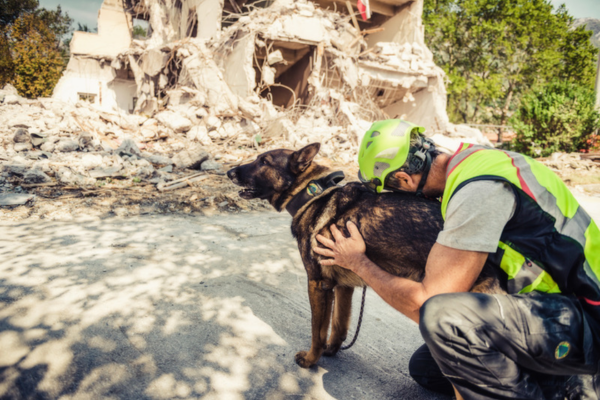Service dogs help disabled handlers carry out everyday tasks. They can be their eyes and ears. A service animal serves as a calming presence in stressful times, aids with mobility, and detects health abnormalities.
These dogs can also provide aid during emergencies. They can be active in search and rescue, disasters, medical incidents, and other life-and-death situations. With the right animal emergency preparedness, they can save lives.
Types of Service Dogs in Disaster Response
Several types of service dogs are active in disaster response. Examples include:
- Search and Rescue Dogs: Search and rescue dogs are trained to detect human scent. They can smell the skin flakes, water, and oil secretion unique to a specific person. Dogs can look for missing persons and find people underwater, in snow, inside collapsed buildings, or trapped in debris.
- Cadaver Dogs: Cadaver dogs are often used by law enforcement. They are trained to sniff out the scent of decomposition. The dogs are often used in homicides, cases of missing persons, and disaster recovery.
- Therapy Dogs for Disaster Victims: Therapy dogs offer comfort to people affected by disaster and trauma. They promote a sense of calm and reduce anxiety. The service animals help people dealing with loss feel connected and engaged.
- Medical Alert Dogs: Medical alert dogs are trained to detect and respond to certain medical conditions. They can sense blood sugar changes in diabetics, anticipate seizures, sense serious allergic reactions, alert handlers, and call for help in an emergency.
Training and Preparation
A service dog will receive special training to ensure animal emergency preparedness. Here are some examples:
- Specialized Training Techniques: Service dogs learn training techniques that vary according to their responsibilities. For example, if they care for a disabled person, they are trained to detect changes in their owner’s body chemistry, allowing them to alert their owners or get help. They may do this by barking, pawing, or bringing specific items to their handler, such as medications and medical devices.
- Simulated Disaster Scenarios: Dogs that help in disasters and investigations often learn during simulated disaster scenarios. They may be prompted to take action in simulated fire evacuation scenarios, high-noise environments, and water rescue operations. The training ensures they can focus in high-stress situations.
- Handler Training and Certification: Service dogs aren’t the only ones who require training; their handlers also do. They may be required to undergo training in Federal Emergency Management, Search and Rescue, and First Aid. They will also learn canine-specific topics like scent theory and dog behavior.
- Ongoing Skill Maintenance: Emergency dog training is not a one-and-done solution because dogs require continuous training to keep their skills sharp. They may also require training in new techniques and technology.
Roles in Disaster Preparedness
Animal emergency preparedness is multifaceted. Here are some factors to consider.
- Public Education and Awareness: Dog lovers may see a service dog and be tempted to pet and play with it. However, this activity can cause the dog to lose focus and put handlers and other individuals at risk. Law enforcement and local organizations may raise awareness of service dog duties to ensure the public follows recommended guidelines regarding service dogs.
- Drills and Exercises: Service dogs often undergo drills and exercises to ensure they are prepared for emergencies. For example, law enforcement may recreate disaster areas and have dogs find dolls in the rubble.
- Equipment Familiarization: Service dogs may wear equipment like identification tags and patches, a harness, and a vest. This equipment is not required, but it helps people identify the animal as a service dog, so they will be less likely to play with it. Similarly, the dog must be familiar with equipment that helps handlers carry out tasks, such as medications, radios, pagers, and First Aid kits.
Roles in Emergency Response
Service dogs have several roles in emergency response. They include:
- Locating Survivors in Rubble: Service dogs often sift through rubble and find people, whether dead or alive. Their agility helps them navigate rough terrain. A keen sense of smell helps them sniff out bodies.
- Water Search and Rescue: A service dog’s sense of smell also helps in water search and rescue missions. Dogs can determine areas where scent is strongest to narrow search areas for divers, reducing time and effort.
- Avalanche Rescue: Some service dogs are specifically trained to navigate challenging alpine terrain and help find avalanche victims.
- Wildfire Evacuation Assistance: Service dogs can guide people through smoke-filled areas and accompany handlers with limited access. They can also plan emergency evacuations with handlers and alert them when fire is detected.
Post-Disaster Recovery
A service dog is not only active during a disaster, but it also helps with post-disaster recovery. Here are some ways they can assist:
- Emotional Support for Victims and First Responders: A service dog’s soothing presence helps victims feel calm and connected. They can also help first responders deal with traumatic incidents.
- Ongoing Search Efforts: After a disaster, service dogs can continue assisting with search efforts and help find missing people.
- Community Healing and Resilience: When service dogs soothe disaster victims and assist with rescue efforts, they do more than help an individual. They promote a sense of healing and resilience that can be felt throughout the community.
Case Studies
Service dogs played a vital role in several historic disasters. They assisted with rescue missions during the September 11 attacks and helped victims of Hurricane Katrina.
9/11 World Trade Center Response
It is estimated that over 300 dogs joined the World Trade Center rescue mission on 9/11. They began searching for survivors, later uncovered remains, and comforted people impacted by the disaster. Dogs Salty and Roselle received a joint Dickin Medal for guiding blind victims down over 70 floors in the World Trade Center. Roselle was posthumously named American Dog Hero of the Year.
Hurricane Katrina Search and Rescue Efforts
26 canine disaster search teams were deployed to Gulfport, Biloxi, and New Orleans to assist with Hurricane Katrina rescue efforts. The dogs were primarily tasked to look for voids in the wreckage where humans could survive. They also searched designated areas and partially collapsed houses to determine if rescue workers could safely navigate the property.
VIII. Challenges and Considerations
A service animal works hard. They are prone to environmental hazards and other dangers as follows.
- Environmental Hazards for Working Dogs: Working dogs face environmental hazards like air pollution, biohazards, asbestos, surgical smoke, and allergies. Some have died in the line of duty.
- Ethical Considerations: Several ethical considerations protect service dogs. Training focuses on animal welfare and includes matching dogs to their human companions. National programs also protect service dogs after they retire or are deemed unfit for continued service.
- Funding and Resource Allocation: Funding and resource allocation are in place to ensure dogs are well cared for during their service and throughout their lives.
Future of Service Dogs in Disaster Response
Disaster response technology is constantly evolving and will continue to develop to ensure service dogs provide efficient services while protecting their well-being.
- Technological Advancements: GPS tracking helps crews find missing persons by providing accurate location data. Dogs can be implanted with this technology to assist with the search and ensure they don’t go missing. Dogs may also wear protective vests and dog armor and carry emergency kits. This technology is evolving, and more resources are available to assist in search efforts.
- Integration with Other Emergency Response Systems: Today, emergency response systems can alert first response crews and locals when disasters occur so they can evacuate and take other precautions. Perhaps, one day, dogs will be integrated into this chain so they can take early action.
- International Cooperation and Standards: The International Search and Rescue Dog Organization recognizes emergency service dogs worldwide. However, not all countries are updated on cooperation and standards. Hopefully, the future will bring a more aware society.
Conclusion
Service dogs play a vital role in disaster preparedness and response. They can find missing persons, excavate remains, and provide comfort in painful times. The dogs can work in various landscapes, ensuring success in multiple applications.
Take the time to support organizations that train and deploy these dogs. Many accept donations and provide volunteer opportunities. They offer rewarding experiences to animal lovers and caring souls.
Justice Speaks supports their efforts by raising awareness for dog and handler rights. We teach children to act properly around service dogs, support workplace compliance, and advocate for handler rights.
Contact us to learn more about what you can do to support service dogs in your community.


